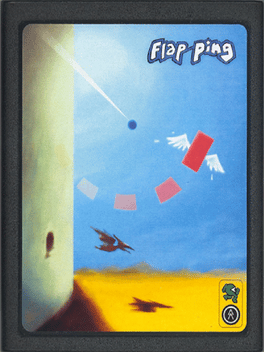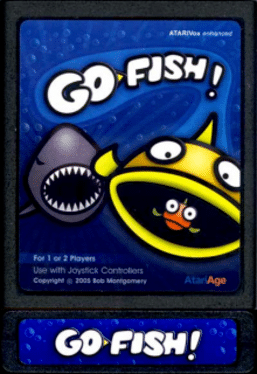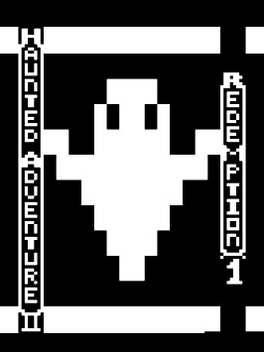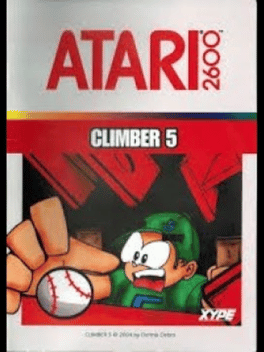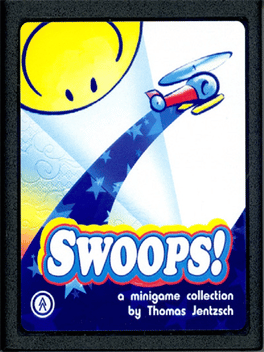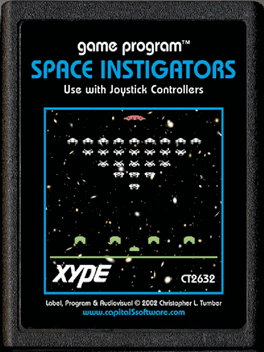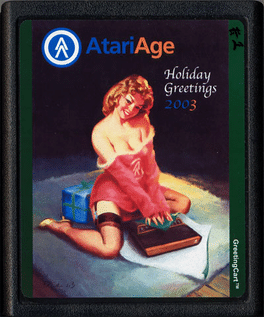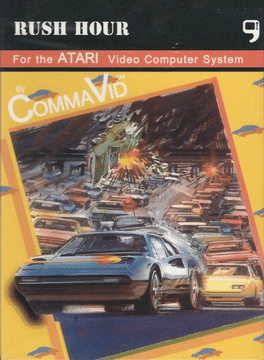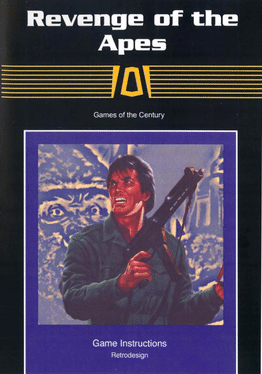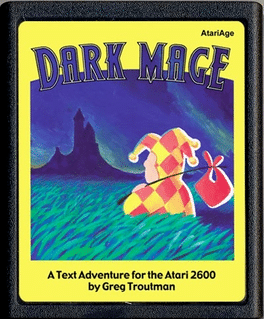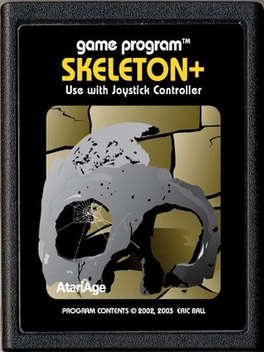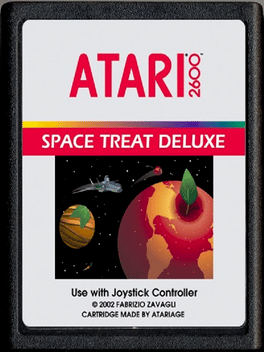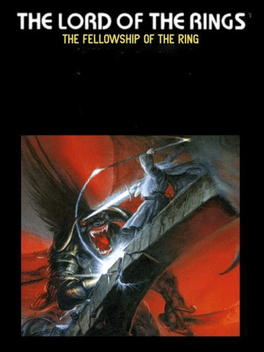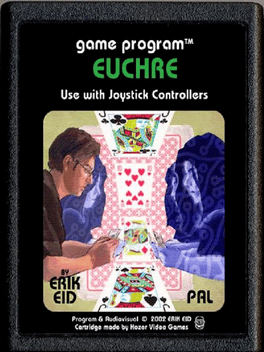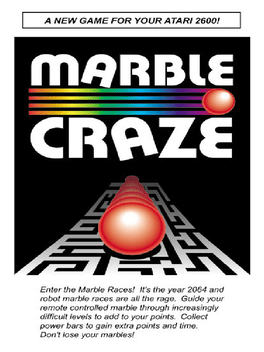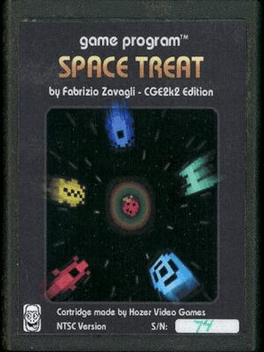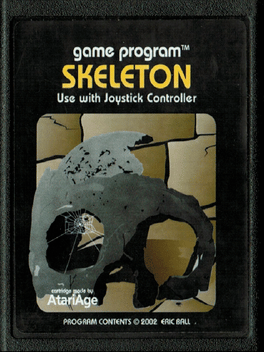New Atari 2600 Games - Page 7
-
FlapPing
2005
FlapPing
2005
"The future of gaming can be summed up in two words -- Pong and Joust." ...with these prophetic words on rec.games.video.classic, "Otter" planted the seeds for the game you see before you now. FlapPing, at its core, is an oldschool Pong Deathmatch... but with a "Flap" button. Each player flaps furiously to prevent the opponent from getting a ball past and scoring a point--first to 10 points win (3 points in a "poorlords" game). FlapPing features two primary game variations, a "classic pong" mode which resembles the classic Pong arcade game, and "poorlords", where each player must defend a wall in a manner similar to the arcade game Warlords. You can play another human, or take on all the AI might of your Atari 2600. The Pterodactyl of Joust also makes an appearance in FlapPing, adding an unpredictable element to the gameplay! FlapPing is descended from JoustPong, the name Kirk Israel originally chose for his original homebrew game. Unfortunately, this name stepped on the Pong trademark owned by Atari, and in earl -
Go Fish!
2005
Go Fish!
2005
Go Fish! is an original game loosely based on the Intellivision game Shark! Shark! - you are a wee fish and, to survive, you must eat other, smaller fish to grow. But watch out for the shark, as he's also on the hunt for food and you could be his next meal! Go Fish! features extensive, continuously-playing music (with an option to turn it off for those who'd rather do their fishing in quiet), as well as a two-player battle mode. Go Fish! is one of the first homebrew games to support Richard Hutchinson's AtariVox. Go Fish! takes advantage of the AtariVox to save your high score, which is retained when you turn your Atari 2600 off. When you come back later to play Go Fish! and power on your 2600, your previous high score will be restored! Programmer Bob Montgomery teamed up with AtariAge to sponsor a contest to create original artwork for Go Fish! The winning label from Renato Brito will grace all copies of Go Fish!, as well as the full-color manual created by Tony Morse. Go Fish! can be purchased in cartridge form -
Poker Squares
2005
Poker Squares
2005
In Poker Squares your goal is to place 25 playing cards (from a deck of 52), one at a time, in a 5x5 grid. Your goal is to make the best ten (or twelve) poker hands, five horizontally, five vertically, and optionally the two diagonals, scoring as many points as possible. -
Haunted Adventure II - Redemption
2004
A mod of Nukey Shay's 8kAdvent and my original Haunted Adventure II -
Pineapple 2000
2004
Pineapple 2000
2004
Pineapple 2000 is a remixed and revamped version of Space Invaders that pits a gingerbread man warrior against an army of invading Fruitoids. -
Atari Climber
2004
Atari Climber
2004
Climber 5 is a port of an Atari 8-bit computer game that originally appeared in COMPUTE! magazine back in 1987. In Climber you play the role of a baseball player. The baseball has been hit to the upper rafters of a building under construction. Your job is to climb the ladders and retrieve the ball. Of course, there are obstacles along the way that you need to avoid or you lose a life and must start over at the bottom right corner. Once you successfully retrieve the ball, the level changes and becomes more difficult. When the game was released in Atari Flashback 2, it was retitled to Atari Climber. -
Swoops!
2004
Swoops!
2004
SWOOPS! is a collection of three 1K minigames that Thomas Jentzsch (author of Thrust+ Platinum) submitted in the 2004 Minigame Competition. Two of the games in this collection won first and second place in the 1K competition: Cave 1K won the category, and Splatform came in second place. All three of these games offer addicting gameplay that will keep you coming back for me! SWOOPS! contains a menu that allows you to select which game to play, as well as a "3-Athlon" mode that allows you to play all three games in succession. -
Space Instigators
2003
Space Instigators
2003
This is an unauthorized conversion of the 1978 Taito coin-op game Space Invaders for the Atari 2600. Unlike the authorized Atari Space Invaders, this version has all nine rows of invaders without flicker, rather than just six. Also, the sounds are closer to the arcade game. Gameplay is the same - shoot the rows of invaders and avoid their bullets, using your bases as shields and taking out the enemy mothership when it appears. -
2003 AtariAge Holiday Cart
2003
The 2003 AtariAge Holiday Cart was created by Andrew Davie and given out to anyone purchasing $50 or more from the AtariAge Store during the 2003 holiday season. The cart displays an image seen below and flips horizontally every few seconds. This was just a demo for Andrew Davie's script to display higher resolution images. -
Rush Hour
2003
Rush Hour
2003
star 6You are speeding along on a five lane highway during rush hour dodging several obstacles like nails, barricades or destroyed cars. Your mission is to destroy the perpetrators causing traffic jams in blasting them off the street. Collisions of any sort will slow you down and eventually cause your car to break down. The game was set for a 1983 release but was ultimately cancelled. In 2003, however, the CGE Services Corp. acquired the rights and released it at the Classic Gaming Expo in 2003. -
Revenge of the Apes
2003
Revenge of the Apes
2003
Planet of the Apes, later released as Revenge of the Apes, is a video game originally developed in 1983 by 20th Century Fox for the Atari 2600. Planned as the Planet of the Apes franchise's first video game, it was still in the prototype phase when Fox shuttered its game division during the video game crash of 1983. It went unreleased and was assumed lost until 2002, when collectors identified a mislabeled cartridge as the missing Planet of the Apes game. It was completed and released as Revenge of the Apes by Retrodesign in 2003. -
Dark Mage
2003
Dark Mage
2003
If you've ever played a classic text adventure, a genre made famous by Infocom in the early 80s, then Dark Mage will be an unexpected pleasure for you. Greg Troutman managed to squeeze a text adventure into an 8K Atari 2600 cart, and although it's much simpler in execution than Infocom's offerings, it's an enjoyable game nonetheless. In Dark Mage, you play the role of a jester banished from your kingdom and your goal is to find and return the king's black rose. As in most text adventures you explore the game world by moving through the four compass directions, find and use items and talk with characters you encounter along the way. This is all accomplished with relative ease through the use of the joystick controller, there's no typing here! -
Skeleton+
2003
Skeleton+
2003
Skeleton+ is a 3D maze game written by Eric Ball. In order to escape this labyrinth you need to hunt down and eliminate 80 skeletons lurking about without being killed yourself! There are eight mazes, with each maze containing 10 skeletons. Complete all eight mazes and you'll gain your freedom! Skeleton+ contains several improvements over the original release of Skeleton. The major differences are: Life and Kill Counters New Undead Locator to help track Skeletons Five vs Ten Skeletons per level (selectable) Various difficulty settings -
Space Treat Deluxe
2003
Space Treat Deluxe
2003
In Space Treat Deluxe, you control a ship that must reach the top of the screen, collect the tasty treat located there, and get it back to its base at the bottom. -
Synthcart
2002
Synthcart
2002
The Synthcart is a rather unique title for the 2600 that allows you to play music using a pair of keyboard controllers. Each keyboard controller controls one of the two oscillators in the Atari 2600. -
The Lord of the Rings: The Fellowship of the Ring
2002
A condensed text adventure based on the popular book. -
Euchre
2002
Euchre
2002
Euchre is an adaptation of the card game of the same name that is popular in the midwestern and northeast United States. -
Marble Craze
2002
Marble Craze
2002
Marble Craze is a homebrew Atari 2600 game developed by Paul Slocum. It's a side by side split-screen one or two player game where you roll a marble along a path across multiple screens to a finish line. The game uses paddle controllers, and it is the first game where each player uses two paddles to control the game: one is used to control the marble's vertical movement and the other is used for horizontal. The goal of Marble Craze is to navigate through each level within the time limit and in later levels, without falling off the edges. There are bonuses, hidden areas, ramps and a lot of other stuff to keep it interesting. It's got 18 levels that go from very easy to insanely hard, and several in-game songs that push the Atari 2600's sound chip to its limits. -
Space Treat
2002
Space Treat
2002
In Space Treat, you control a ship that must reach the top of the screen, collect the tasty treat located there, and get it back to its base at the bottom. -
Skeleton
2002
Skeleton
2002
"You are in a maze of twisty passages, all alike," certainly describes the situation you are in. You hear faint footsteps, so you follow the sound through the maze. To your horror, you discover the source of the footsteps is a skeleton; and it doesn't look friendly. Acting quickly, you blast it with your undead Disintegrator and the skeleton vanishes in a flash of color, but as you reload your UD, you hear footsteps again; and you wonder; are you the hunter of the hunted in this nightmare?
